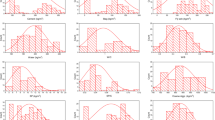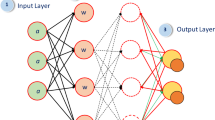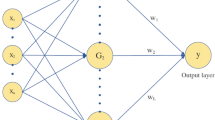Abstract
In this study, we use highly developed machine learning techniques to accurately estimate the Compressive Strength (CS) of blended concrete, considering its composition, including cement, SCMs (Ground Granulated Blast Furnace Slag (GGBFS) and Fly Ash (FA)), water, superplasticizer, fine/coarse aggregate, and curing age. In addition to these, we examine an array of models, including XGBoost, Decision Trees (DT), Deep Neural Networks (DNN), and Linear Regression (LR). Among them, XGBoost has the best performance in every category. We use the Bayesian optimization method for hyperparameter fine-tuning to improve forecast accuracy. Our in-depth examination demonstrates the better predictive skills of ensemble models like RF and XGBoost over LR, which is limited in capturing data complexity beyond linear relationships. With an R2 of 0.952, RMSE of 4.88, MAE of 3.24, and MAPE of 9.94%, XGBoost performs noticeably better than its rivals. Using SHAP analysis, we determine that curing age, water content and cement concentration are the main factors influencing the model’s predictive capacity, with the contributions of superplasticizer and fly ash being minimal. Curing age and cement content have an interesting positive association with CS, but water content has a negative link with CS. These results highlight the value of machine learning, especially the effectiveness of XGBoost, as a potent device for forecasting the CS of mixed concrete. Additionally, the knowledge gained from our research provides designers and researchers in concrete materials with useful direction, highlighting the most important factors for compressive strength. Future studies should work toward additional optimization by attempting to verify these models across a wider variety of concrete compositions and test settings.








Similar content being viewed by others
Data availability
The datasets used and analyzed during the current study are available from the corresponding author upon reasonable request.
References
Ahmad, A., Chaiyasarn, K., Farooq, F., Ahmad, W., Suparp, S., & Aslam, F. (2021). Compressive strength prediction via gene expression programming (GEP) and artificial neural network (ANN) for concrete containing RCA. Buildings, 11(8), 324. https://doi.org/10.3390/BUILDINGS11080324
Al-Hashem, M. N., Amin, M. N., Raheel, M., Khan, K., Alkadhim, H. A., Imran, M., Ullah, S., & Iqbal, M. (2022). Predicting the compressive strength of concrete containing fly ash and rice husk ash using ANN and GEP models. Materials, 15(21), 7713. https://doi.org/10.3390/MA15217713
Alsahaf, A., Petkov, N., Shenoy, V., & Azzopardi, G. (2022). A framework for feature selection through boosting. Expert Systems with Applications, 187, 115895. https://doi.org/10.1016/J.ESWA.2021.115895
Asteris, P. G., Skentou, A. D., Bardhan, A., Samui, P., & Pilakoutas, K. (2021). Predicting concrete compressive strength using hybrid ensembling of surrogate machine learning models. Cement and Concrete Research, 145, 106449. https://doi.org/10.1016/J.CEMCONRES.2021.106449
Ayus, I., Natarajan, N., & Gupta, D. (2023). Comparison of machine learning and deep learning techniques for the prediction of air pollution: A case study from China. Asian Journal of Atmospheric Environment, 17(1), 1–22. https://doi.org/10.1007/S44273-023-00005-W/FIGURES/14
Balan, S. (2021). Metaheuristics in Optimization: Algorithmic Perspective. https://www.informs.org/Publications/OR-MS-Tomorrow/Metaheuristics-in-Optimization-Algorithmic-Perspective
Behnood, A., & Golafshani, E. M. (2018). Predicting the compressive strength of silica fume concrete using hybrid artificial neural network with multi-objective grey wolves. Journal of Cleaner Production, 202, 54–64. https://doi.org/10.1016/J.JCLEPRO.2018.08.065
Bilim, C., Atiş, C. D., Tanyildizi, H., & Karahan, O. (2009). Predicting the compressive strength of ground granulated blast furnace slag concrete using artificial neural network. Advances in Engineering Software, 40(5), 334–340. https://doi.org/10.1016/J.ADVENGSOFT.2008.05.005
Chakraborty, D., Awolusi, I., & Gutierrez, L. (2021). An explainable machine learning model to predict and elucidate the compressive behavior of high-performance concrete. Results in Engineering, 11, 100245. https://doi.org/10.1016/J.RINENG.2021.100245
Chen, T., & Guestrin, C. (2016). Xgboost: A scalable tree boosting system. Proceedings of the 22nd Acm Sigkdd International Conference on Knowledge Discovery and Data Mining, 785–794.
Cheng, M. Y., Chou, J. S., Roy, A. F. V., & Wu, Y. W. (2012). High-performance concrete compressive strength prediction using time-weighted evolutionary fuzzy support vector machines inference model. Automation in Construction, 28, 106–115. https://doi.org/10.1016/J.AUTCON.2012.07.004
Chou, J. S., & Tsai, C. F. (2012). Concrete compressive strength analysis using a combined classification and regression technique. Automation in Construction, 24, 52–60. https://doi.org/10.1016/J.AUTCON.2012.02.001
Czarnecki, S., Hadzima-Nyarko, M., Chajec, A., & Sadowski, Ł. (2022). Design of a machine learning model for the precise manufacturing of green cementitious composites modified with waste granite powder. Scientific Reports, 12, 13242. https://doi.org/10.1038/s41598-022-17670-6
de-Prado-Gil, J., Palencia, C., Silva-Monteiro, N., & Martínez-García, R. (2022). To predict the compressive strength of self compacting concrete with recycled aggregates utilizing ensemble machine learning models. Case Studies in Construction Materials, 16, e01046. https://doi.org/10.1016/J.CSCM.2022.E01046
Dong, W., Huang, Y., Lehane, B., & Ma, G. (2020). XGBoost algorithm-based prediction of concrete electrical resistivity for structural health monitoring. Automation in Construction, 114, 103155. https://doi.org/10.1016/J.AUTCON.2020.103155
Elbaz, K., Shen, S. L., Zhou, A., Yuan, D. J., & Xu, Y. S. (2019). Optimization of EPB shield performance with adaptive neuro-fuzzy inference system and genetic algorithm. Applied Sciences, 9(4), 780. https://doi.org/10.3390/APP9040780
Elbaz, K., Shen, S. L., Sun, W. J., Yin, Z. Y., & Zhou, A. (2020). Prediction model of shield performance during tunneling via incorporating improved particle swarm optimization into ANFIS. IEEE Access, 8, 39659–39671. https://doi.org/10.1109/ACCESS.2020.2974058
Elbaz, K., Shen, S. L., Zhou, A., Yin, Z. Y., & Lyu, H. M. (2021). Prediction of disc cutter life during shield tunneling with AI via the incorporation of a genetic algorithm into a GMDH-type neural network. Engineering, 7(2), 238–251. https://doi.org/10.1016/J.ENG.2020.02.016
Faridmehr, I., Nikoo, M., Pucinotti, R., & Bedon, C. (2021). Application of component-based mechanical models and artificial intelligence to bolted beam-to-column connections. Applied Sciences, 11(5), 2297.
Feng, D. C., Liu, Z. T., Wang, X. D., Chen, Y., Chang, J. Q., Wei, D. F., & Jiang, Z. M. (2020). Machine learning-based compressive strength prediction for concrete: An adaptive boosting approach. Construction and Building Materials, 230, 117000. https://doi.org/10.1016/j.conbuildmat.2019.117000
Friedman, J. H. (2001). Greedy function approximation: A gradient boosting machine. Annals of Statistics, 29, 1189–1232.
Goldstein, A., Kapelner, A., Bleich, J., & Pitkin, E. (2015). Peeking inside the black box: Visualizing statistical learning with plots of individual conditional expectation. Journal of Computational and Graphical Statistics, 24(1), 44–65. https://doi.org/10.1080/10618600.2014.907095
Gupta, S. K., & Ramteke, M. (2014). Applications of genetic algorithms in chemical engineering I: Methodology. Applications of Metaheuristics in Process Engineering, 9783319065083, 39–59. https://doi.org/10.1007/978-3-319-06508-3_2
Hüllermeier, E., & Waegeman, W. (2021). Aleatoric and epistemic uncertainty in machine learning: An introduction to concepts and methods. Machine Learning, 110(3), 457–506. https://doi.org/10.1007/S10994-021-05946-3/FIGURES/17
Huseien, G. F., & Shah, K. W. (2020). Durability and life cycle evaluation of self-compacting concrete containing fly ash as GBFS replacement with alkali activation. Construction and Building Materials, 235, 117458. https://doi.org/10.1016/j.conbuildmat.2019.117458
IEA. (2022). Global Energy and Climate Model. 129 p.
Imam, A., Salami, B. A., & Oyehan, T. A. (2021). Predicting the compressive strength of a quaternary blend concrete using Bayesian regularized neural network. Journal of Structural Integrity and Maintenance, 6(4), 237–246. https://doi.org/10.1080/24705314.2021.1892572
International Energy Agency. (2022). International Energy Agency (IEA) World Energy Outlook 2022. https://www.iea.org/reports/world-energy-outlook-2022/executive-summary, 524. https://www.iea.org/reports/world-energy-outlook-2022
Jiang, H., Liu, G., Alyami, H., Alharbi, A., Jameel, M., & Khadimallah, M. A. (2022). Intelligence decision mechanism for prediction of compressive strength of self-compaction green concrete via neural network. Journal of Cleaner Production, 340, 130580. https://doi.org/10.1016/J.JCLEPRO.2022.130580
Junda, E., Málaga-Chuquitaype, C., & Chawgien, K. (2023). Interpretable machine learning models for the estimation of seismic drifts in CLT buildings. Journal of Building Engineering, 70, 106365.
Kashifi, M. T., Al-Sghan, I. Y., Rahman, S. M., & Alahmadi, H. (2022). Spatiotemporal grid-based crash prediction—Application of a transparent deep hybrid modeling framework. Neural Computing and Applications. https://doi.org/10.1007/s00521-022-07511-y
Kashifi, M. T., Jamal, A., Samim, M., Almoshaogeh, M., & Masiur, S. (2022b). Predicting the travel mode choice with interpretable machine learning techniques: A comparative study. Travel Behaviour and Society, 29(July), 279–296. https://doi.org/10.1016/j.tbs.2022.07.003
Kaveh, A., & Khalegi, A. (1998). Prediction of strength for concrete specimens using artificial neural networks. Advances in Engineering Computational Technology, 165–171.
Kaveh, A., & Khavaninzadeh, N. (2023). Efficient training of two ANNs using four meta-heuristic algorithms for predicting the FRP strength. Structures, 52, 256–272.
Kaveh, A., Elmieh, R., & Servati, H. (2001). Prediction of moment-rotation characteristic for semi-rigid connections using BP neural networks.
Kaveh, A., Gholipour, Y., & Rahami, H. (2008). Optimal design of transmission towers using genetic algorithm and neural networks. International Journal of Space Structures, 23(1), 1–19. https://doi.org/10.1260/026635108785342073
Kaveh, A., Seddighian, M. R., & Farsi, N. (2023). a Metaheuristic-Based Artificial Neural Network for Plastic Limit Analysis of Frames Tt -. Iust, 13(2), 143–154. http://ijoce.iust.ac.ir/article-1-546-en.html
Kazemi, F., Asgarkhani, N., & Jankowski, R. (2023). Machine learning-based seismic response and performance assessment of reinforced concrete buildings. Archives of Civil and Mechanical Engineering, 23(2), 94.
Khan, M. A., Memon, S. A., Farooq, F., Javed, M. F., Aslam, F., & Alyousef, R. (2021). Compressive strength of fly-ash-based geopolymer concrete by gene expression programming and random forest. Advances in Civil Engineering. https://doi.org/10.1155/2021/6618407
Khan, K., Salami, B. A., Iqbal, M., Amin, M. N., Ahmed, F., & Jalal, F. E. (2022). Compressive strength estimation of fly ash/slag based green concrete by deploying artificial intelligence models. Materials, 15(10), 3722. https://doi.org/10.3390/MA15103722
Khan, M. A., Aslam, F., Javed, M. F., Alabduljabbar, H., & Deifalla, A. F. (2022). New prediction models for the compressive strength and dry-thermal conductivity of bio-composites using novel machine learning algorithms. Journal of Cleaner Production, 350, 131364. https://doi.org/10.1016/J.JCLEPRO.2022.131364
Kondraivendhan, B., & Bhattacharjee, B. (2016). Strength and w/c ratio relationship of cement based materials through pore features. Materials Characterization, 122, 124–129. https://doi.org/10.1016/J.MATCHAR.2016.10.036
Kumar, R., Shafiq, N., Kumar, A., & Jhatial, A. A. (2021). Investigating embodied carbon, mechanical properties, and durability of high-performance concrete using ternary and quaternary blends of metakaolin, nano-silica, and fly ash. Environmental Science and Pollution Research, 28(35), 49074–49088. https://doi.org/10.1007/s11356-021-13918-2
Li, Q., & Song, Z. (2023). Prediction of compressive strength of rice husk ash concrete based on stacking ensemble learning model. Journal of Cleaner Production, 382, 135279. https://doi.org/10.1016/J.JCLEPRO.2022.135279
Lundberg, S. M., & Lee, S.-I. (2017). A unified approach to interpreting model predictions. Proceedings of the 31st International Conference on Neural Information Processing Systems, 4768–4777.
Mangalathu, S., Shin, H., Choi, E., & Jeon, J. S. (2021). Explainable machine learning models for punching shear strength estimation of flat slabs without transverse reinforcement. Journal of Building Engineering, 39, 102300. https://doi.org/10.1016/J.JOBE.2021.102300
Mao, J., Su, X., Wang, H., & Li, J. (2023). Automated Bayesian operational modal analysis of the long-span bridge using machine-learning algorithms. Engineering Structures, 289, 116336.
Molnar, C. (2020). Interpretable machine learning. Lulu. com.
Moncada-Torres, A., van Maaren, M. C., Hendriks, M. P., Siesling, S., & Geleijnse, G. (2021). Explainable machine learning can outperform Cox regression predictions and provide insights in breast cancer survival. Scientific Reports, 11(1), 1–13. https://doi.org/10.1038/s41598-021-86327-7
Murdoch, W. J., Singh, C., Kumbier, K., Abbasi-Asl, R., & Yu, B. (2019). Definitions, methods, and applications in interpretable machine learning. Proceedings of the National Academy of Sciences of the United States of America, 116(44), 22071–22080. https://doi.org/10.1073/pnas.1900654116
Naser, M. Z. (2021). An engineer’s guide to explainable artificial intelligence and interpretable machine learning: Navigating causality, forced goodness, and the false perception of inference. Automation in Construction, 129, 103821. https://doi.org/10.1016/J.AUTCON.2021.103821
Nguyen, H., Vu, T., Vo, T. P., & Thai, H. T. (2021). Efficient machine learning models for prediction of concrete strengths. Construction and Building Materials, 266, 120950. https://doi.org/10.1016/J.CONBUILDMAT.2020.120950
Oteiza, P. P., Rodríguez, D. A., & Brignole, N. B. (2018). Parallel cooperative optimization through hyperheuristics. Computer Aided Chemical Engineering, 44, 805–810. https://doi.org/10.1016/B978-0-444-64241-7.50129-4
Puth, M. T., Neuhäuser, M., & Ruxton, G. D. (2014). Effective use of Pearson’s product–moment correlation coefficient. Animal Behaviour, 93, 183–189. https://doi.org/10.1016/J.ANBEHAV.2014.05.003
Rahman, J., Ahmed, K. S., Khan, N. I., Islam, K., & Mangalathu, S. (2021). Data-driven shear strength prediction of steel fiber reinforced concrete beams using machine learning approach. Engineering Structures, 233, 111743. https://doi.org/10.1016/J.ENGSTRUCT.2020.111743
Rai, A. (2020). Explainable AI: From black box to glass box. Journal of the Academy of Marketing Science, 48(1), 137–141. https://doi.org/10.1007/S11747-019-00710-5/TABLES/1
Ren, Q., Li, H., Li, M., Kong, T., & Guo, R. (2023). Bayesian incremental learning paradigm for online monitoring of dam behavior considering global uncertainty. Applied Soft Computing, 143, 110411.
Sadrossadat, E., Basarir, H., Karrech, A., & Elchalakani, M. (2021). Multi-objective mixture design and optimisation of steel fiber reinforced UHPC using machine learning algorithms and metaheuristics. Engineering with Computers, 1, 1–14. https://doi.org/10.1007/S00366-021-01403-W/TABLES/5
Salami, B. A., Rahman, S. M., Oyehan, T. A., Maslehuddin, M., & Al Dulaijan, S. U. (2020). Ensemble machine learning model for corrosion initiation time estimation of embedded steel reinforced self-compacting concrete. Measurement: Journal of the International Measurement Confederation, 165, 108141. https://doi.org/10.1016/J.MEASUREMENT.2020.108141
Salami, B. A., Olayiwola, T., Oyehan, T. A., & Raji, I. A. (2021). Data-driven model for ternary-blend concrete compressive strength prediction using machine learning approach. Construction and Building Materials. https://doi.org/10.1016/J.CONBUILDMAT.2021.124152
Sarker, I. H. (2021). Machine learning: algorithms, real-world applications and research directions. SN Computer Science, 2(3), 1–21. https://doi.org/10.1007/S42979-021-00592-X/FIGURES/11
Shah, M. I., Memon, S. A., Khan Niazi, M. S., Amin, M. N., Aslam, F., & Javed, M. F. (2021). Machine learning-based modeling with optimization algorithm for predicting mechanical properties of sustainable concrete. Advances in Civil Engineering. https://doi.org/10.1155/2021/6682283
Shapley, L. S. (2016). 17. A value for n-person games. New Jersey: Princeton University Press. https://doi.org/10.1515/9781400881970-018
Shariati, M., Mafipour, M. S., Mehrabi, P., Ahmadi, M., Wakil, K., Trung, N. T., & Toghroli, A. (2020). Prediction of concrete strength in presence of furnace slag and fly ash using Hybrid ANN-GA (Artificial Neural Network-Genetic Algorithm). Smart Structures and Systems, 25(2), 183–195. https://doi.org/10.12989/SSS.2020.25.2.183
Shoaei, P., Ameri, F., Reza Musaeei, H., Ghasemi, T., & Cheah, C. B. (2020). Glass powder as a partial precursor in Portland cement and alkali-activated slag mortar: a comprehensive comparative study. Construction and Building Materials, 251, 118991. https://doi.org/10.1016/j.conbuildmat.2020.118991
Silva, P. F. S., Moita, G. F., & Arruda, V. F. (2020). Machine learning techniques to predict the compressive strength of concrete. Revista Internacional de Métodos Numéricos Para Cálculo y Diseño En Ingeniería, 36(4), 1–14. https://doi.org/10.23967/J.RIMNI.2020.09.008
Singh, C. (2022). Useful interpretability for real-world machine learning.
Smith, G. N. (1986). Probability and statistics in civil engineering : an introduction. 244.
Song, H., Ahmad, A., Farooq, F., Ostrowski, K. A., Maślak, M., Czarnecki, S., & Aslam, F. (2021). Predicting the compressive strength of concrete with fly ash admixture using machine learning algorithms. Construction and Building Materials, 308, 125021. https://doi.org/10.1016/J.CONBUILDMAT.2021.125021
USGS. (2022). Mineral Commodity Summaries 2022. Diatomite. Angewandte Chemie International Edition, 6(11), 951–952., 703, 10–27. https://doi.org/10.3133/MCS2022
van Dao, D., Ly, H. B., Trinh, S. H., Le, T. T., & Pham, B. T. (2019). Artificial intelligence approaches for prediction of compressive strength of geopolymer concrete. Materials, 12(6), 983. https://doi.org/10.3390/MA12060983
WBCSD. (2021). Time to Transform: Vision 2050. World Business Council for Sustainable Development, 1–118. https://timetotransform.biz/wp-content/uploads/2021/03/WBCSD_Vision_2050_Time-To-Transform.pdf
Wu, Y., & Zhou, Y. (2022). Hybrid machine learning model and Shapley additive explanations for compressive strength of sustainable concrete. Construction and Building Materials, 330, 127298. https://doi.org/10.1016/J.CONBUILDMAT.2022.127298
Xi, F., Davis, S. J., Ciais, P., Crawford-Brown, D., Guan, D., Pade, C., Shi, T., Syddall, M., Lv, J., Ji, L., Bing, L., Wang, J., Wei, W., Yang, K. H., Lagerblad, B., Galan, I., Andrade, C., Zhang, Y., & Liu, Z. (2016). Substantial global carbon uptake by cement carbonation. Nature Geoscience, 9(12), 880–883. https://doi.org/10.1038/ngeo2840
Xue, J., Xiang, Z., & Ou, G. (2021). Predicting single freestanding transmission tower time history response during complex wind input through a convolutional neural network based surrogate model. Engineering Structures, 233, 111859. https://doi.org/10.1016/j.engstruct.2021.111859
Yeh, I. C. (1998). Modeling of strength of high-performance concrete using artificial neural networks. Cement and Concrete Research, 28(12), 1797–1808. https://doi.org/10.1016/S0008-8846(98)00165-3
Zahedi, M., & Golchin, S. (2022). Prediction of blast loading on protruded structures using machine learning methods. International Journal of Protective Structures. https://doi.org/10.1177/20414196221144067
Zeng, Z., Zhu, Z., Yao, W., Wang, Z., Wang, C., Wei, Y., Wei, Z., & Guan, X. (2022). Accurate prediction of concrete compressive strength based on explainable features using deep learning. Construction and Building Materials, 329, 127082. https://doi.org/10.1016/J.CONBUILDMAT.2022.127082
Acknowledgements
The authors gratefully acknowledge the support of the King Fahd University of Petroleum & Minerals (KFUPM) for conducting this research.
Funding
Not applicable.
Author information
Authors and Affiliations
Contributions
MTK—methodology, software, investigation, data curation, writing—original draft, writing—review and editing, visualization, supervision, project administration. BAS: resources, project administration, conceptualization, methodology, software, investigation, data curation, writing—original draft, writing—review and editing, supervision, project administration. SMR: conceptualization, methodology, project administration, supervision, writing—review and editing, validation. WA: data gathering, data preparation.
Corresponding author
Ethics declarations
Conflict of interest
The authors declare that they have no known contrasting financial or personal interests regarding this study.
Ethical approval
Not applicable.
Consent to participate
Not applicable.
Consent to publish
The authors agree to publish the submitted manuscript.
Additional information
Publisher's Note
Springer Nature remains neutral with regard to jurisdictional claims in published maps and institutional affiliations.
Rights and permissions
Springer Nature or its licensor (e.g. a society or other partner) holds exclusive rights to this article under a publishing agreement with the author(s) or other rightsholder(s); author self-archiving of the accepted manuscript version of this article is solely governed by the terms of such publishing agreement and applicable law.
About this article
Cite this article
Kashifi, M.T., Salami, B.A., Rahman, S.M. et al. Using explainable machine learning to predict compressive strength of blended concrete: a data-driven metaheuristic approach. Asian J Civ Eng 25, 219–236 (2024). https://doi.org/10.1007/s42107-023-00769-0
Received:
Accepted:
Published:
Issue Date:
DOI: https://doi.org/10.1007/s42107-023-00769-0




